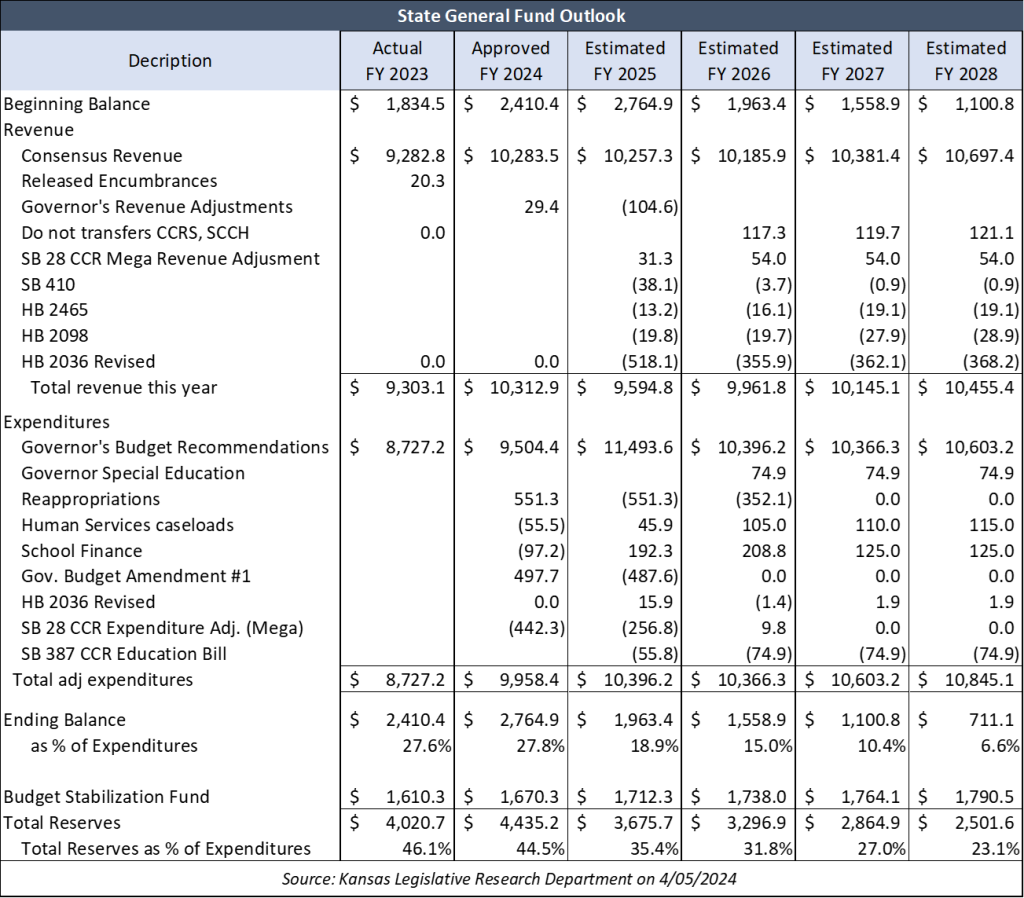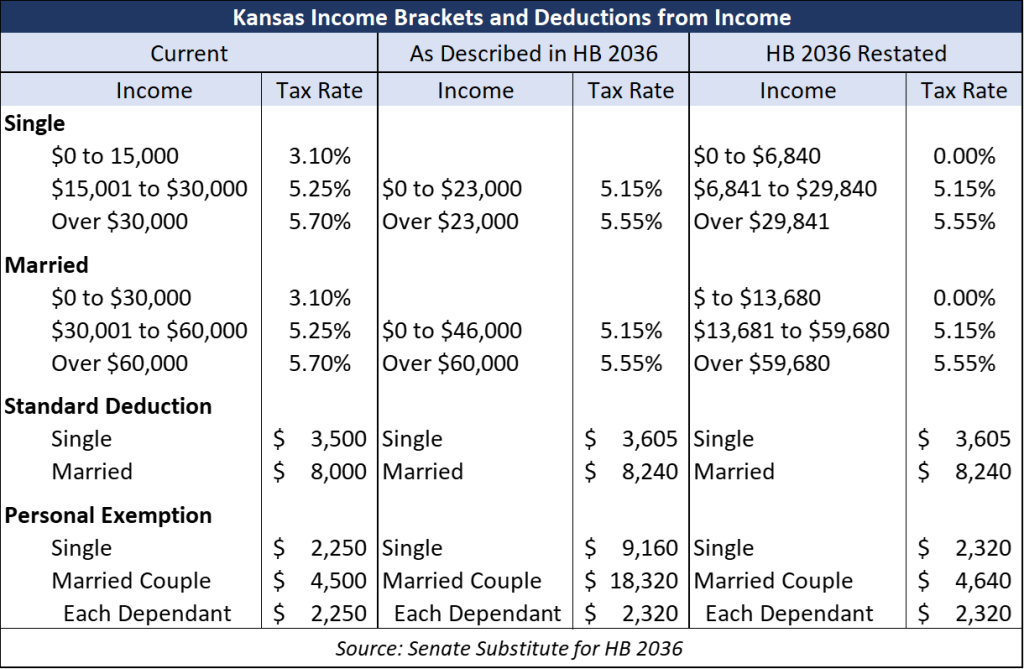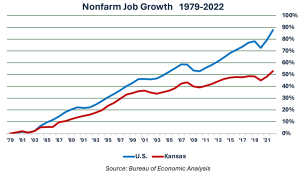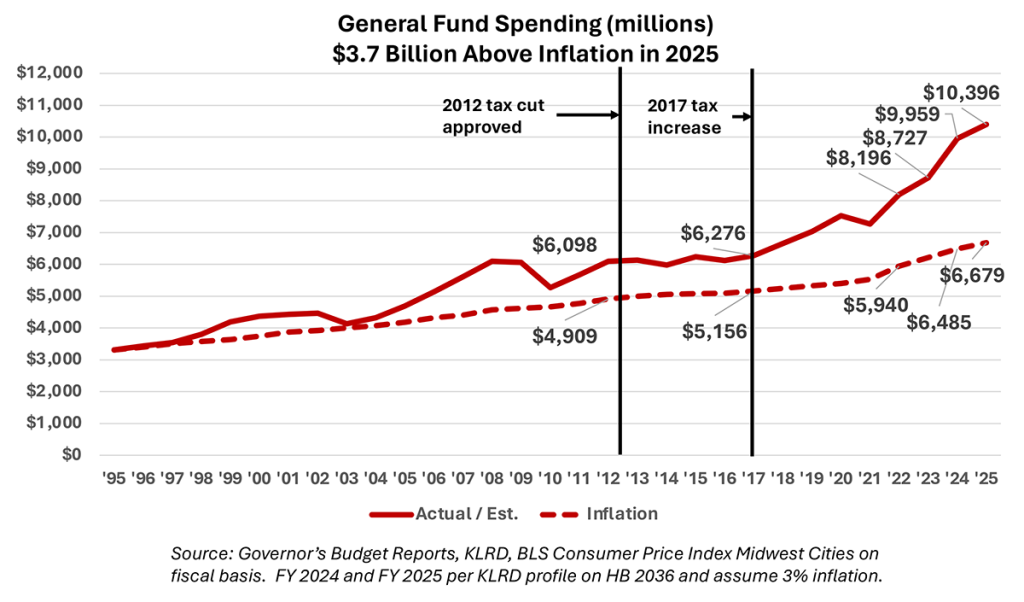After personally lobbying House Democrats to approve a similar tax relief plan she negotiated with top Republicans, Kansas Governor Laura Kelly is now pondering whether to veto HB 2036. However, many of the governor’s other actions contradict her stated concerns over a bill that passed with strong bipartisan support (119-0 in the House and 24-9 in the Senate).
For example, Kelly says her initial reaction is that HB 2036 is “too expensive.” However, the Kansas Legislative Research Department (KLRD) tells the Legislature that it costs only $146.5 million more over four years, or about $36.6 million annually. That amounts to a proverbial ‘hill of beans’ – only 0.35% of a $10.5 billion General Fund budget average over the same period.
KLRD prepared the long-term forecast below, which includes the impact of HB 2036. After four years of tax relief, the state would still have $2.5 billion in reserves, including an ending balance of $711 million and $1.8 billion in a separate Budget Stabilization Fund. That cash stockpile is left after absorbing an anticipated $2.1 billion spending increase since FY 2023 (more on that later).

While Gov. Kelly says tax relief for individuals in HB 2036 may be “too expensive,” she has no problem handing out billions of dollars in subsidies to a small number of companies and other unnecessary uses of taxpayer money. Here are just a few examples of Kelly putting all the eggs in one or a few baskets instead of reducing taxes for people:
- $829 million to Panasonic
- More than $3 billion in HPIP tax credits to companies 2018-2020.
- $1.1 billion in HPIP tax credits for 2022 (per email to legislators from KLRD).
- $400 million in PEAK incentives to companies 2017-2021 (most current data).
- Kelly wants to give about $175 million annually to cities and counties for theoretical property tax relief, which would only subsidize higher spending as it did when last funded 20 years ago.
- $304 million to Integra if it builds a chip manufacturing plant in Wichita.
The full extent of the state’s handouts to favored businesses is unknown. Kelly’s Lt. Governor and Commerce Secretary David Toland won’t provide the details to the Legislature despite repeated requests, according to Rep. Kristey Williams (R-Augusta).
“On three separate occasions during Legislative Post Audit and Commerce Committees of this session, I’ve asked the Department of Commerce to provide total expenditures toward economic incentives through our major tax credits. They’ve more than once assured us that those numbers were forthcoming, but to date, we’ve only received partial answers. The truth must be so troubling that every effort is made to conceal rather than bring light on the actual amount of giveaways provided.”
House Commerce Committee Chair Sean Tarwater (R-Stillwell) says more transparency is needed on the subsidy programs.
“When I recently read some of these numbers, I was surprised at how high they were. These incentive programs have been around for many years, and we have tried to create more transparency by passing laws in the House and Senate Commerce Committees. A few years ago, I worked with Representative Kristey Williams to create a law for a transparency website. We really need to update this law to make it easier for people, especially lawmakers, to see how much we spend on these programs and better decide whether the return on investment is working in our favor.”
A Kelly veto of HB 2036 would deny a $98 income tax savings to a single person who earns $50,000… a $260 income tax savings to a family of four with a $40,000 income…as “too expensive” while handing hundreds of millions of dollars of taxpayer money to a relative handful of companies. Research repeatedly shows that subsidy programs do not work except for the recipients and politicians who use them to curry votes.
‘Too expensive’ is just one of Gov. Kelly’s preposterous ponderings on HB 2036. Others include:
Kelly: maintaining a three-tier tax system is incredibly important going forward; “if anything, I want more tiers.”
Facts: Gov. Kelly lobbied House Democrats to approve the initial version of HB 2036 with two rates. The plan includes a large increase in the personal exemption to exempt more income from taxation, but the Legislature could have accomplished the same outcome by increasing the personal exemption by 3% to $2,320 and having a tax rate of 0% on the first $6,840 of income ($9,160 minus $2,320) instead of adding that amount to the personal exemption.
HB 2036 increases the standard deduction by 3% to $3,605; it raises the single personal exemption from $2,250 to $9,160, and the first $23,000 of income is taxed at 5.15%. The table below shows how the tax tables could have been designed with just a 3% increase in the standard deduction and use the difference to create a 0% bracket applicable to the first $6,840 single and $13,680 married. The benefit to taxpayers is the same, so this is nothing “incredibly important” to having three tax rates as Kelly would have you believe.

Kelly: relief might not be sustainable if tax collections slow.
Facts: tax projections are very conservative – the Consensus Revenue Estimate (CRE) for FY 2025 is a decline of 0.3%. In the budget forecast above, KLRD assumes another decline of 0.7% for FY 2026, followed by increases of 1.9% and 3.0%.
New CRE estimates will be published in a few days, and we will update the budget forecast when those numbers are finalized.
Kelly: billions in reserves should not be used for structural tax reform, just one-time rebates.
Facts: Kansas had a net loss of $364 in Adjusted Gross Income from people moving to states with a lower tax burden, according to the most recent IRS data for 2021. Conversely, Kansas had a net gain of $129 million AGI from people moving here from states with higher tax burdens.

The Tax Foundation says 32 states have a lower tax burden than Kansas, and the IRS data shows people voting with their feet for a better economic deal. Only Nebraska and Iowa had higher burdens in the Tax Foundation’s review of 2022 data, but both states cut income tax last year. Kansas is now likely the most expensive state in the region for people, and Governor Kelly wants to make it worse (“If anything, I want more tiers”).
 The economic data clearly shows the need for tax relief. Kansas is in its fifth straight decade of economic stagnation and is falling farther behind national average increases in job growth, population, and economic activity (GDP).
The economic data clearly shows the need for tax relief. Kansas is in its fifth straight decade of economic stagnation and is falling farther behind national average increases in job growth, population, and economic activity (GDP).
Our research shows that states with lower tax burdens have superior economic growth. To put that in perspective, there would be 451,000 more jobs in Kansas today if nonfarm employment had grown at the national average since 1979.
HB 2036 veto would fuel more spending
General Fund spending has jumped 56% since Governor Kelly took office, from $6.649 billion in FY 2018 to $10.396 billion for FY 2025. Spending was $1.2 billion above long-term inflation in FY 2018 and will be $3.7 billion higher next year.

If she vetoes HB 2036 and the Legislature cannot override it, Kelly would want to spend even more (and the majority of both parties in the Legislature would likely go along with it, as has happened so far).
Even House Minority Leader Vic Miller (D-Topeka) says Kelly should sign the bill.
“I’m a fiscal conservative, but I think people looking for tax relief have waited long enough. We have, in my opinion, healthy balances both now and after we implement this plan. Good Lord, there’s $1.7 billion sitting in a rainy day fund.”
Governor Kelly has vetoed every piece of major tax relief during her reign. Continuing that streak will help her continue to grow government at the expense of people and the economy.





